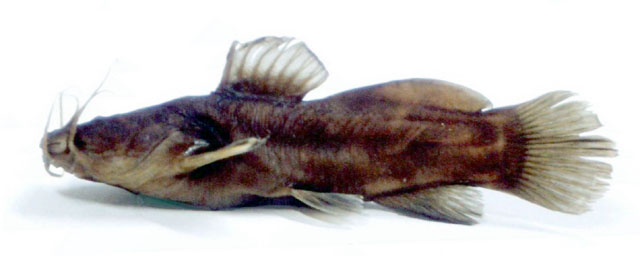| Claroteidae (Claroteid catfishes), subfamily: Auchenoglanidinae |
| 10.7 cm SL (male/unsexed) |
|
demersal; freshwater, |
| Africa: Niger Delta and the neighbouring New Calabar River, Bonny River and Imo River in southern Nigeria (Ref. 7324, 50225, 57126, 94168). |
|
Dorsal spines (total): 2-2; Dorsal soft rays (total): 7-7; Anal spines: 0-0; Anal soft rays: 10-13; Vertebrae: 36-36. Diagnosis: Notoglanidium akiri differs from other species in the genus in having: an average interorbital distance, 24.1-32.8% of head length vs. smaller in N. boutchangai, N. depierrei, N. pallidum and N. pembetadi, and larger in N. maculatum and N. thomasi; a large eye diameter, 6.6-10.5% of head length vs. smaller in N. maculatum and N. pallidum; a deep adipose fin, 4.7-7.3% of standard length vs. less deep in other species except N. macrostoma and N. walkeri; an average combined premaxillary tooth plate width, 22.0-26.1% of head length vs. broader in N. boutchangai and N. macrostoma and smaller in allother species except N. depierrei and N. pembetadi; only seven soft branched dorsal-fin rays, vs. more than 8 in N. depierrei, N. maculatum, N. pallidum, N. pembetadi, N. thomasi and N. walkeri; and a high dorsal-fin spine length, 9.8-12.8% of standard length vs. shorter in all other species except N. macrostoma (Ref. 94168).
Description: Snout only moderately depressed, body not depressed, predorsal body depth 19.5-24.4% of standard length, minimal caudal peduncle depth 13.0-15.9% of standard length, head depth 58.0-75.9% of head length (Ref. 94168). Eyes very small, 6.6-10.5% of head length, situated dorsally on the first half of the head, and covered with a thin skin layer, lacking a free border around; supraoccipital process and first nuchal plate both very small and well separated from each other (Ref. 50225). Premaxillary toothplate broad, 22-27% of head length (Ref. 50225). Branchiostegal membranes completely fused (Ref. 50225, 94168). Short caudal peduncle, with a minimal height much larger than the horizontal distance between the bases of the adipose fin and the caudal fin (Ref. 50225). Dorsal fin rays II,7; pectoral fin rays I,6-7; pelvic fin rays i,5; anal fin rays iii-iv,7-9; caudal fin rays 16-18; pectoral fin reaching the base of the pelvic fin, or a little further; adipose fin rather high, at 4.7-7.3% of standard length (Ref. 50225, 94168).
Colouration: In alcohol, brown to greyish; in juveniles the flanks and the adipose fin have a reticulate pattern which may vaguely persist or disappear in adults; dorsal and caudal fins sometimes spotted; other fins always uniformly greyish (Ref. 50225, 94168). |
|
|
Endangered (EN); Date assessed: 20 August 2019 (B1ab(i,ii,iii)+2ab(i,ii,iii)) Ref. (130435)
|
| harmless |
|
Type locality of the holotype of Auchenoglanis akiri: 'Umayara Mba, Etche, Rivers State, Nigeria (5°12'N-7°06'E)' (Ref. 47263). Known from southwestern Nigeria in Niger Delta (Ref. 7324, 31256, 50225, 57126) with the neighbouring New Calabar River (Ref. 31256, 50225, 57126, 94168), and Imo River (Ref. 7324, 31256, 57126, 94168). |
Source and more info: www.fishbase.org. For personal, classroom, and other internal use only. Not for publication.

